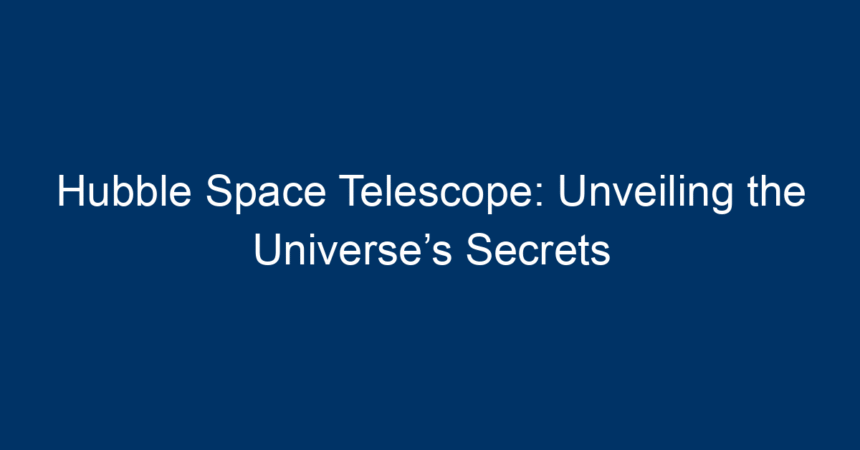The Hubble Space Telescope has become a cornerstone of modern astronomy, providing unprecedented insights into the vast expanse of the universe. Launched on April 24, 1990, aboard the Space Shuttle Discovery, Hubble has transformed our understanding of space, revealing the hidden beauty of celestial phenomena and challenging our comprehension of cosmic evolution. In this article, we will explore the Hubble Space Telescope’s impressive capabilities, its significant contributions to astronomy, and the mysteries it continues to unravel.
The Vision Behind Hubble
The concept for the Hubble Space Telescope emerged in the early 1940s, primarily driven by the desire to minimize Earth’s atmospheric interference in astronomical observations. Unlike ground-based telescopes, which struggle with blurred images caused by the atmosphere, the Hubble Space Telescope orbits Earth, allowing it to capture stunningly clear images.
Key Features of the Hubble Space Telescope
Hubble is equipped with advanced technological features that set it apart from its terrestrial counterparts:
- High-Resolution Imaging: Hubble’s primary mirror, measuring 2.4 meters in diameter, enables it to capture high-resolution images of distant cosmic objects.
- Wide Range of Wavelengths: Hubble observes in the ultraviolet, visible, and near-infrared spectra, allowing it to detect a diverse range of astronomical phenomena, from hot, young stars to the faint glow of distant galaxies.
- Stable Platform: Orbiting approximately 547 kilometers (about 340 miles) above Earth’s surface, Hubble avoids atmospheric distortions, producing clearer and more detailed images.
The Collaborative Effort Behind Hubble
The Hubble Space Telescope is the result of a collaborative effort between NASA and the European Space Agency (ESA). This partnership has allowed scientists from around the world to contribute to Hubble’s continued success. The telescope’s operations and scientific endeavors are overseen by the Space Telescope Science Institute (STScI), where teams of astronomers plan observations, analyze data, and publish groundbreaking research.
Hubble’s Groundbreaking Discoveries
The Hubble Space Telescope has made a multitude of discoveries that have reshaped our understanding of the cosmos. Here are some of its most profound contributions:
1. The Expanding Universe
One of Hubble’s landmark findings was the discovery that the universe is expanding at an accelerating rate. In the 1990s, Hubble observed distant supernovae, leading to the conclusion that a mysterious force, now known as dark energy, is driving this acceleration. This realization opened new avenues of research into the fundamental nature of the universe.
2. The Age of the Universe
By observing globular clusters and distant galaxies, Hubble has helped astronomers refine the age of the universe to approximately 13.8 billion years. This measurement is crucial for understanding cosmic history and the timeline of galactic formation.
3. The Formation of Galaxies
Hubble’s deep-field images, where astronomers focused on a small region of the sky for an extended period, revealed thousands of galaxies, some of which are billions of light-years away. These observations have provided insights into the formation and evolution of galaxies, showing how they have changed over time.
4. Exoplanet Studies
Hubble has also played a crucial role in the study of exoplanets, or planets outside our solar system. By analyzing the atmospheres of these distant worlds, Hubble has provided evidence of potentially habitable conditions, including the detection of water vapor in some exoplanet atmospheres.
5. Cosmic Violence: Black Holes and Supernovae
Hubble has captured stunning images of powerful cosmic events, such as supernovae and the mysterious phenomena surrounding black holes. Its ability to observe these events in detail has led to a better understanding of stellar life cycles and the dynamics of massive celestial bodies.
Hubble’s Impact on Astronomy and Beyond
The effects of the Hubble Space Telescope extend far beyond the realm of astronomy. Its images have inspired countless individuals, fueling interest in science and space exploration. Hubble’s contributions have also enhanced our understanding of fundamental scientific concepts, leading to innovations in technology, optics, and various scientific fields.
Hubble’s Educational Role
Hubble serves an educational purpose as well, offering valuable resources for students, educators, and the general public. Through various programs and outreach initiatives, NASA and the STScI provide educational materials, videos, and interactive experiences to foster a deeper appreciation for the wonders of the universe.
The Future of Hubble
As Hubble continues to operate, questions arise about its longevity and future prospects. While new telescopes, such as the James Webb Space Telescope, are set to take center stage, Hubble remains an essential tool for astronomers. Its ability to complement data from new instruments enhances our understanding of the cosmos and ensures that it will continue to contribute to scientific advancements for years to come.
Conclusion: Embracing the Cosmic Journey
The Hubble Space Telescope has undeniably revolutionized our understanding of the universe, revealing its secrets and expanding our horizons. As we look to the cosmos, Hubble’s legacy inspires curiosity and a quest for knowledge that fuels scientific discovery.
Actionable Insights
For those interested in exploring Hubble’s findings further, here are some suggestions:
- Visit Hubble’s Official Website: Explore stunning images and recent discoveries directly from the source.
- Participate in Citizen Science: Programs like Galaxy Zoo allow you to help classify galaxies using Hubble’s data.
- Engage with Educational Content: Whether through online courses, documentaries, or lectures, increase your understanding of astronomy and Hubble’s role in it.
In doing so, we not only honor the tremendous work of scientists and engineers but also embark on our cosmic journey to unravel the mysteries that the universe holds. The Hubble Space Telescope continues to be a beacon of inspiration, illuminating the path for future explorations beyond our planet.




